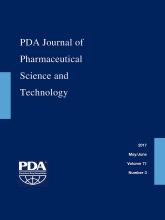Abstract
Subvisible particle formation in monoclonal antibody drug product resulting from mixing and filling operations represents a significant processing risk that can lead to filter fouling and thereby lead to process delays or failures. Several previous studies from our lab and others demonstrated the formation of subvisible particulates in mAb formulations resulting from mixing operations using some bottom-mounted mixers or stirrer bars. It was hypothesized that the stress (e.g., shear/cavitation) derived from tight clearance and/or close contact between the impeller and shaft was responsible for protein subvisible particulate generation. These studies, however, could not distinguish between the two surfaces without contact (tight clearance) or between two contacting surfaces (close contact). In the present study we expand on those findings and utilize small-scale mixing models that are able to, for the first time, distinguish between tight clearances and tight contact. In this study we evaluated different mixer types including a top-mounted mixer, several impeller-based bottom-mounted mixers, and a rotary piston pump. The impact of tight clearance/close contact on subvisible particle formation in at-scale mixing platforms was demonstrated in the gap between the impeller and drive unit as well as between the piston and the housing of the pump. Furthermore, small-scale mixing models based on different designs of magnetic stir bars that mimic the tight clearance/close contact of the manufacturing-scale mixers also induced subvisible particles in mAb formulations. Additional small-scale models that feature tight clearance but no close contact (grinding) suggested that it is the repeated grinding/contacting of the moving parts and not the presence of tight clearance in the processing equipment that is the root cause of protein subvisible particulate formation. When multiple mAbs, Fabs (fragment antigen binding), or non-antibody related proteins were mixed in the small-scale mixing model, for molecules investigated, it was observed that mAbs and Fabs appear to be more susceptible to particle formation than non-antibody-related proteins. In the grinding zone, mAb/Fab molecules aggregated into insoluble particles with neither detectable soluble aggregates nor fragmented species. This investigation represents a step closer to the understanding of the underlying stress mechanism leading to mAb subvisible particulate formation as the result of drug product processing.
LAY ABSTRACT: Mixing and fill finish are important unit operations in drug product manufacturing for compounding (dilution, pooling, homogenization, etc.) and filling into primary packaging containers (vials, pre-filled syringes, etc.), respectively. The current trend in adopting bottom-mounted mixers as well as low fill-volume filling systems has raised concerns about their impact on drug product quality and process performance. However, investigations into the effects of their use for biopharmaceutical products, particularly monoclonal antibody formulations, are rarely published. The purpose of this study is three-fold: (1) to revisit the impact of bottom-mounted mixer design on monoclonal antibody subvisible particle formation; (2) to identify the root cause for subvisible particle formation; and (3) to fully utilize available particle analysis tools to demonstrate the correlation between particle count in the solution and filter fouling during sterile filtration. The outcomes of this study will benefit scientists and engineers who develop biologic product manufacturing processes by providing a better understanding of drug product process challenges.
- Bottom-mounted mixers
- Monoclonal antibody
- LevMixer®
- Mobius® mixer
- JetMixer™
- Filter fouling
- Subvisible particles
- Rotary piston pump
- © PDA, Inc. 2017
PDA members receive access to all articles published in the current year and previous volume year. Institutional subscribers received access to all content. Log in below to receive access to this article if you are either of these.
If you are neither or you are a PDA member trying to access an article outside of your membership license, then you must purchase access to this article (below). If you do not have a username or password for JPST, you will be required to create an account prior to purchasing.
Full issue PDFs are for PDA members only.
Note to pda.org users
The PDA and PDA bookstore websites (www.pda.org and www.pda.org/bookstore) are separate websites from the PDA JPST website. When you first join PDA, your initial UserID and Password are sent to HighWirePress to create your PDA JPST account. Subsequent UserrID and Password changes required at the PDA websites will not pass on to PDA JPST and vice versa. If you forget your PDA JPST UserID and/or Password, you can request help to retrieve UserID and reset Password below.






